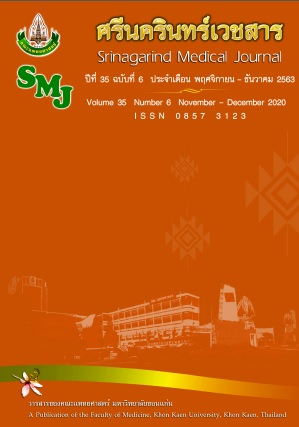Position of Resuscitative Endovascular Balloon Occlusion of the Aorta (REBOA) in Thai People
Keywords:
REBOA; Abdominal hemorrhage; Resuscitation; Shock; TraumaAbstract
Background and Objective: Major cause of trauma death worldwide is from non-compressible torso hemorrhage. Currently, Resuscitative Endovascular Balloon Occlusion of the Aorta (REBOA) plays role in control of intraabdominal bleeding. Therefore, it is necessary to use several methods to confirm the position of the balloon precisely, such as fluoroscopy. But most hospitals in Thailand do not support fluoroscopic machine in ER. This study aimed to determine the intravascular length for placement REBOA and compare to the appropriate locations of external landmarks of the body.
Method: Human cadaveric study, external anatomical (sternal notch, xyphoid process and umbilicus) and intravascular (left subclavian artery (LSA), celiac trunk (CT), lowest renal artery (LRA) and aortic bifurcation (AB)) landmarks from puncture sites. The landing zones were calculated with intravascular landmarks.
Results: Twenty-two cadavers were analyzed. Mean external landmarks from right groin to umbilicus, xyphoid, sternal notchere 19.20, 32.26, 53.42 cm. and from left groin were 19.25, 32.62, 53.65 cm. The mean intravascular distance from right puncture site to AB, LRA, CT, LSA were 21.37, 30.47, 33.95, 55.97 cm. and from left puncture site were 20.69, 29.72, 32.87, 56.20 cm. There are statistically significant of clinical correlations between external and intravascular length of right groin - umbilicus with right puncture site - AB (p=0.0385) and right groin - sternal notch with right puncture site - LSA root (p=0.303).
Conclusion: The use of external anatomical landmarks to estimate length of REBOA in Zone-1 and Zone-3 with evaluate the clinical response is safe to perform the procedure.
References
1. ต้องพร วรรณธูป. REBOA : Resuscitative Endovascular Balloon Occlusion of the Aorta–Introduction for new life-saving maneuver in Trauma. Thai Journal of Trauma 2559; 35: 93-105.
2. Etienne G. Krug, Gyanendra K. Sharma, Rafael Lozano. The Global Burden of Injuries. Am J Public Health 2000; 90: 523-526.
3. Saito N, Matsumoto H, Yagi T, Hara Y, Hayashida K, Motomura T, et al. Evaluation of the safety and feasibility of resuscitative endovascular balloon occlusion of the aorta. J Trauma Acute Care Surg 2014; 78: 897-904.
4. Morrison JJ, Galgon RE, Jansen JO, Cannon JW, Rasmussen TE, Eliason JL. A systematic review of the use of resuscitative endovascular balloon occlusion of the aorta in the management of hemorrhagic shock. J Trauma Acute Care Surg 2016; 80: 324-334.
5. Gupta BK, Khaneja SC, Flores L, Eastlick L, Longmore W, Shaftan GW. The role of intra-aortic balloon occlusion in penetrating abdominal trauma. J Trauma 1989; 29(6): 861–865.
6. Martinelli T, Thony F, Decléty P, Sengel C, Broux C, Tonetti J, et al. Intra-aortic balloon occlusion to salvage patients with life-threatening hemorrhagic shocks from pelvic fractures. J Trauma 2010; 68(4): 942-948.
7. Stannard A, Eliason JL, Rasmussen TE. Resuscitative endovascular balloon occlusion of the aorta (reboa) as an adjunct for hemorrhagic shock. J Trauma 2011; 71(6): 1869–1872.
8. Ogura T, Lefor AK, Nakamura M, Fujizuka K, Shiroto K, Nakano M. Ultrasound-Guided Resuscitative Endovascular Balloon Occlusion of the Aorta in the Resuscitation Area. J Emerg Med 2017; 52(5): 715–722.
9. Brenner ML, Moore LJ, DuBose JJ, Tyson GH, McNutt MK, Albarado RP, et al. A clinical series of resuscitative endovascular balloon occlusion of the aorta for hemorrhage control and resuscitation. J Trauma Acute Care Surg 2013; 75(3): 506–511.
10. Moore LJ, Brenner M, Kozar RA, Pasley J, Wade CE, Baraniuk MS, et al. Implementation of resuscitative endovascular balloon occlusion of the aorta as an alternative to resuscitative thoracotomy for noncompressible truncal hemorrhage: J Trauma Acute Care Surg 2015; 79(4): 523–532.
11. Linnebur M, Inaba K, Haltmeier T, Rasmussen TE, Smith J, Mendelsberg R, et al. Emergent non–image-guided resuscitative endovascular balloon occlusion of the aorta (REBOA) catheter placement: A cadaver-based study. J Trauma Acute Care Surg 2016; 81(3): 453–457.
12. Qasim ZA, Sikorski RA. Physiologic Considerations in Trauma Patients Undergoing Resuscitative Endovascular Balloon Occlusion of the Aorta. Anesth Anal 2017; 125(3): 891–894.
13. Aso S, Matsui H, Fushimi K, Yasunaga H. Resuscitative endovascular balloon occlusion of the aorta or resuscitative thoracotomy with aortic clamping for noncompressible torso hemorrhage: A retrospective nationwide study. J Trauma Acute Care Surg 2017 ; 82(5): 910–914.
14. Kisat M, Morrison JJ, Hashmi ZG, Efron DT, Rasmussen TE, Haider AH. Epidemiology and outcomes of non-compressible torso hemorrhage. J Surg Res 2013; 184(1): 414–421.
15. Manzano Nunez R, Naranjo MP, Foianini E, Ferrada P, Rincon E, García-Perdomo HA, et al. A meta-analysis of resuscitative endovascular balloon occlusion of the aorta (REBOA) or open aortic cross-clamping by resuscitative thoracotomy in non-compressible torso hemorrhage patients. World J Emerg Surg 2017; 12(1): 30.
16. Russo RM, Neff LP, Lamb CM, Cannon JW, Galante JM, Clement NF, et al. Partial Resuscitative Endovascular Balloon Occlusion of the Aorta in Swine Model of Hemorrhagic Shock. J Am Coll Surg 2016; 223(2): 359–368.
17. Scott DJ, Eliason JL, Villamaria C, Morrison JJ, Houston R, Spencer JR, et al. A novel fluoroscopy-free, resuscitative endovascular aortic balloon occlusion system in a model of hemorrhagic shock. JTrauma Acute Care Surg 2013; 75(1): 122–128.



